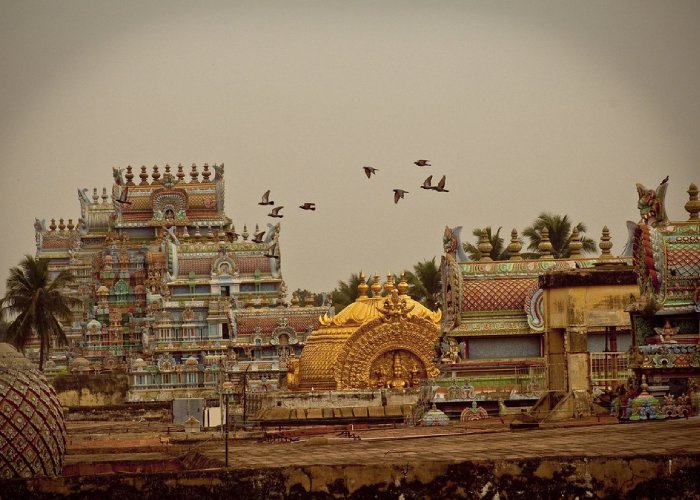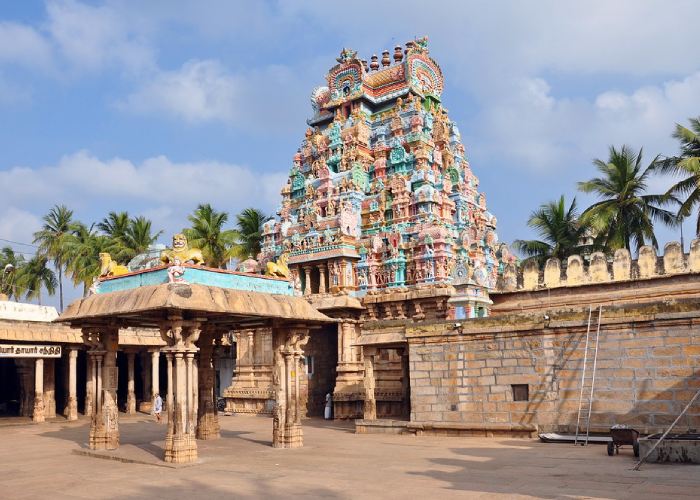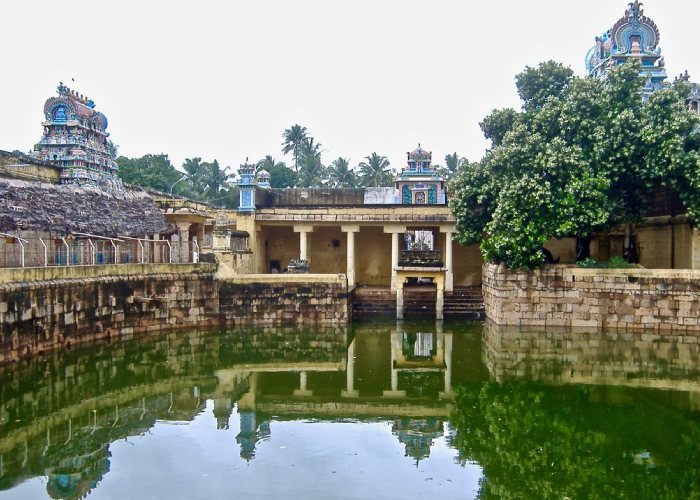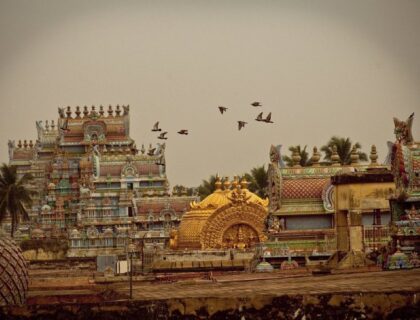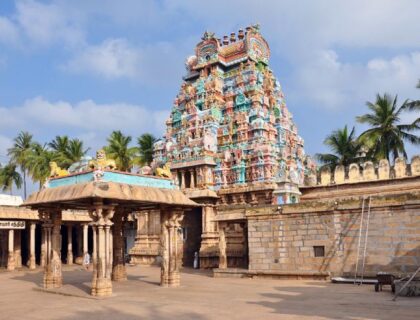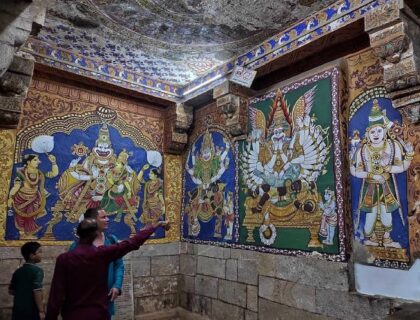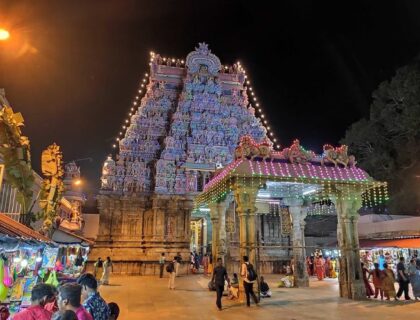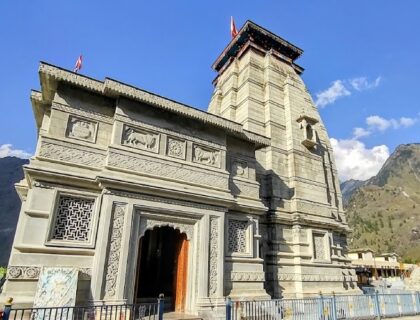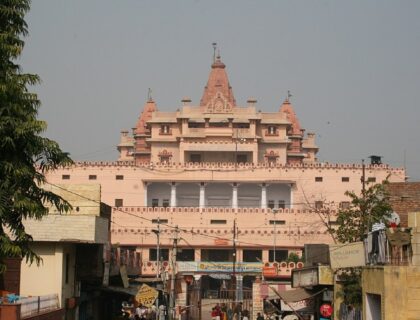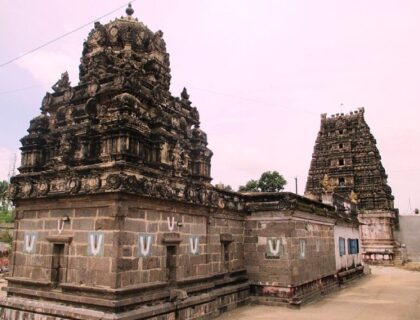Ranganathaswamy Temple Srirangam
Sri Ranganathaswamy Temple is a Hindu temple in Srirangam, Tiruchirapalli, Tamil Nadu, India, dedicated to Ranganatha (a form of Vishnu). The temple, built in the Dravidian architectural style, is praised by Alvars in their Naalayira Divya Prabhandam, and it holds the distinction of being the first of the 108 Divya Desams devoted to the god Vishnu.
It is one of the most revered Vaishnava temples in South India, steeped in tradition and history. Beginning with the 11th-century career of Ramanuja and his predecessors Nathamuni and Yamunacharya in Srirangam, the temple has played an important role in Vaishnavism history.
Significance of the Ranganathaswamy Temple
According to Alwar legends, the shrine is one of Lord Vishnu’s eight Sywayambu Kshetras. The presiding deity here, like seven other important temples in India, is thought to have appeared on its own. The temple is also one of the five sacred Pancharanga Kshetrams dedicated to Lord Ranganatha that are located on the Cauvery River’s banks. Non-Hindus are welcome to visit the shrine up to the second outer courtyard but are not permitted to enter the Sanctum Sanctorum, which is capped with gold. There are 108 holy Vaishnavite shrines also called Divya Desams, and this is considered the most prominent of them all.

What is Divya Desams– A Divya Desam or Vaishnava Divya Desam is one of the 108 Vishnu and Lakshmi temples recorded by the Alvars, the poet-saints of the Sri Vaishnava faith. 105 of the 108 temples are in India, one is in Nepal, and the final two are thought to be in space, in Tirupparkatal and Vaikuntham. They are distributed over the Indian states of Tamil Nadu (84), Kerala (11), Andhra Pradesh (2), Gujarat (1), Uttar Pradesh (4), and Uttarakhand (3). Muktinath, Saligramam is Nepal’s sole Divya Desam. The 12 Alvars respect the Divya Desams in the Naalayira Divya Prabandham, a collection of 4,000 Tamil hymns.
History of Ranganathaswamy Temple
A temple at Srirangam is mentioned in Tamil literature of the Sangam era (6th century BCE to the 4th century CE), including the epic Silapadikaram (book 11, lines 35–40). Dharmavarma, the Chola emperor, was the first to construct the temple. The temple Vimanam was devastated by the Kaveri River flood, and afterwards, the early Cholas King Killivalavan reconstructed the temple complex as it is now.
Aside from old textual material, archaeological evidence such as inscriptions refer to this temple, however these stone inscriptions date from the late first millennium CE. The inscriptions in the temple date from the reigns of the Chola, Pandya, Hoysala, and Vijayanagara dynasties. These inscriptions date from the 9th through the 16th century.

During the period of invasion and plunder by Alauddin Khilji’s Muslim general Malik Kafur and his Delhi Sultanate forces in 1311, Arabic texts of the period state that he raided a “golden temple” on the river “Kanobari” (Kaveri), destroyed the temple, and took the plunder with the deity’s golden icon to Delhi. This is thought to be the Ranganathaswamy Temple, according to Steven P. Hopkins.
Between 1323 CE and 1327 CE, the Sultanate’s soldiers led by Muhammad ibn Tughluq launched a more severe second invasion of South India, including Srirangam. Before the Delhi Sultanate troops arrived in Srirangam, a group led by the Vaishnavite Acharaya Pillai Lokacharyar to Tirunelveli in Tamil Nadu destroyed the sanctum’s Vishnu picture with its jewellery. A second gang also took the Goddess Ranganayaki (Lakshmi) to another spot. According to Tamil tradition, around 13,000 Sri Vaishnava devotees of Srirangam were killed in the violent conflict.
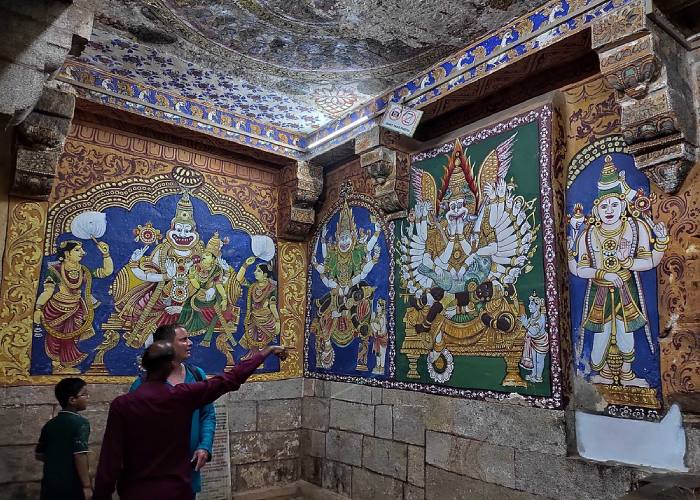
The Vijayanagara Empire toppled the Madurai Sultanate in 1378, some six decades after the Pandyan kings were deposed following numerous Delhi Sultanate incursions. The image of Namberumal was thereafter returned to Srirangam. Previously, the deity and priesthood wardens had strayed and covertly moved the temple’s symbol across villages in Tamil Nadu, Kerala, and Karnataka for decades. They then relocated to Tirumala Tirupati’s hills, where they resided until the temple was erected in 1371.
Architecture of Ranganathaswamy Temple
The temple is surrounded by seven concentric enclosures with courtyards (known as prakarams or mathil suvar). Walls and gopurams were erected or reinforced in and after the 16th century on each stratum. These walls span 32,592 feet (9,934 metres), or more than six miles. Inside the temple are 17 large gopurams (towers, totalling 21), 39 pavilions, 50 shrines, 9 sacred water pools, Ayiram kaal mandapam (a hall of 1000 pillars), and other lesser water bodies.
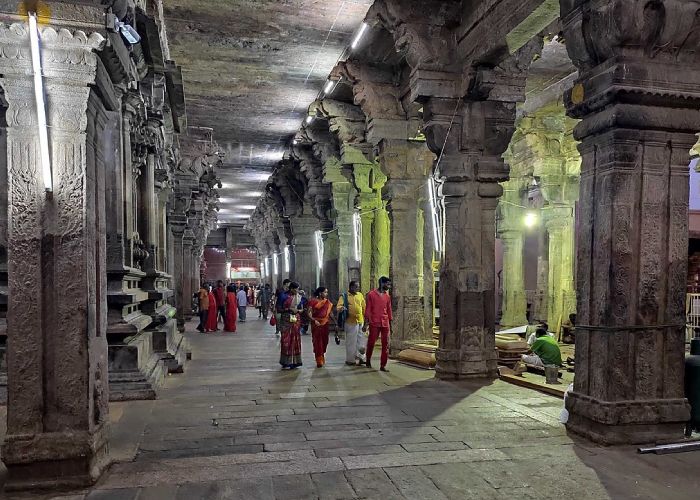
The temple is oriented north-south and east-west on an island surrounded by the Kaveri River. The river is revered and known as the Daksina Ganga, or “Southern Ganges.” The two outer prakarams (courtyards) serve as residential and market areas, with shops, restaurants, and flower stands. The five inner courtyards contain shrines to Vishnu and his many avatars, including Rama and Krishna. There are also major shrines dedicated to the goddess Lakshmi and various Vaishnava saints.

These temples, in particular, honour and remember the Tamil poet-saints and philosophers known as the Alvars, as well as Hindu intellectuals like Ramanuja and Manavala Mamunigal of the Sri Vaishnavism tradition.
Facts about Ranganathaswamy Temple
- Sri Ranganathaswamy Temple is a prominent Hindu temple situated at Srirangam near Trichy. It is one of the famous temples in South India and among the most visited places in Tamilnadu.
- Constructed in the Dravidian style of architecture, Sri Ranganathaswamy Temple is the foremost of the eight self-manifested shrines of Lord Vishnu
- The Ranganathaswamy Temple is also a part of the five sacred Pancharanga Kshetrams dedicated to Lord Ranganatha which are situated on the banks of the Cauvery River.
- This temple lies on an island formed by the twin Rivers Cauvery and Kollidam. Though the temple has existed since the 2nd century BC, the archaeological inscriptions are available only from the 10th century CE.
- Srirangam Divyakshetram also called as `Bhooloka Vaikundam`, Bhoga Mandabam etc.Srirangam temple is the Swayamvyaktha kshetram. The Lord Ranganathaswamy is reclining position (Sayana kolam) facing South.
- The temple holds high importance in the Vaishnav section across the world thus a huge number of devotee visits here from the world to get the blessing of Lord Vishnu.
- The major deity in the garbhagriha is Lord Vishnu in the form of Ranganatha resting on the coils of Adisesha, whose broad seven hoods form a canopy, which is one of the largest idols of Lord Vishnu in a reclining posture.
- One of the key features of the temple is 1000 pillared hall- mandapam, made from granite during the rule of the Vijayanagara Empire in 1336–1565.
- The temple architecture is classic Dravidian. It spans an area of 156 acres, which makes it the largest functioning Hindu temple in the world.
- The striking feature of the temple is its main entrance, the Rajagopuram [royal temple tower] which stands 72 m above the ground and poses its tremendous might and splendour.
- Ranganathaswamy Temple has the most mesmerizing view as it has a tower that provides unique sights to any visitor
- Another fascinating story related to the temple is that of the famed Orlov Diamond, one of the world’s few most precious gems. There is no confirmation of this, although it is claimed that it previously graced the deity’s eyes in Srirangam temple. During the Carnatic War in 1747, a Frenchman stole a diamond from the shrine.
- The most prominent celebrated festival is the 21-day-long Vaikunta Ekadasi (Festival of Paradise) conducted in mid-December.
Famous Festivals In Ranganathaswamy Temple
- Vaikunta Ekadasi – Vaikunta Ekadasi which falls in the month of Margazhi, is the primary festival of the temple and the entire complex comes alive during this 20-day extravaganza.
- Diwali – Diwali is one of the most admired and auspicious festivals in the town.
- Chitra Poornima is also a significant occasion for celebration in the temple.
- Brahmotsav – The traditional Brahmotsavam is celebrated in Paguni month [March-April]. Another important and crowded gathering is during the Ratholsavam (Temple Chariot Festival) when the deities inside the temple are mounted on a well-decorated chariot and are paraded around the temple.
How To reach Ranganathaswamy Temple
Tiruchirappalli is well-connected with Road, Rail and Air Routes
By Air: The Ranganathaswamy Temple is 15 kilometres from Tiruchirappalli. Air Terminal
By Railway: The Ranganathaswamy Temple is 9 kilometres from Tiruchirappalli Railway Station.
By Roadways: Bus services (Route No. 1) are available 24 hours a day, 7 days a week from Tiruchirappalli Railway Station, Central Bus Stop, and Chatiram Bus Stop.
Also, Read – Shri Purushothaman Perumal Temple , Pundarikakshan Perumal Temple
Support Us
If our content helps you even 1% in gaining information about the temple, please support us by contributing any amount, our UPI ID is - q417999792@ybl Or pay using QR CODE >>> Click Now
Location
Facilities
- Drinking Water
- Pooja Item Shops
- Prasad Shops
- Restaurants Nearby
- Resting Room



